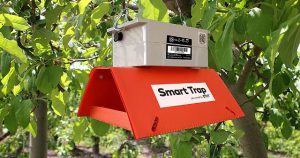Introducing a new in-field trapping tool for veg growers
The Bowen Gumlu region in far-north Queensland is on high alert following the detection of fall armyworm in March this year. Assisting growers in the battle against this exotic pest – as well as a range of other target species – is a new ‘smart trap’. VegNET Regional Development Officer Eilis Walker reports on this latest technology and how it will benefit vegetable growers.
Fall armyworm (Spodoptera frugiperda) is an exotic pest that was first detected on two islands in the Torres Strait in January this year. It reached the mainland after being detected in the far-north Queensland town of Bamaga in February and was first detected in Bowen on 17 March.
The pest has the potential to significantly damage over 350 different commodities and can devastate high value crops that are grown in the Bowen Gumlu region, including sweet corn, sorghum, maize, capsicums and other palatable fruits and vegetables.
Bowen Gumlu Growers Association President Carl Walker said the greatest concern with fall armyworm is resistance.
“We are concerned that pests or diseases from overseas – such as fall armyworm – may already have resistance to the chemicals we rely on,” Carl said.
The Consultative Committee on Emergency Plant Pests has determined that it is not technically feasible to eradicate fall armyworm from Australia, as it has never been eradicated anywhere else in the world.
Finding pest solutions
To address this significant issue, a global provider of actionable data insights is changing the way farmers detect and count invasive, damaging pests in the field. DTN has developed Smart Trap technology, which utilises sticky cards and pheromone lures in the base of the trap to attract the target pest species.
A high-resolution camera then captures images of pests caught in the trap and transmits these to a cloud server. These are then analysed and counted by DTN’s computer software. Daily trap images and target pest counts are sent to the growers’ Agronomic Platform account, which is easily accessible via mobile or computer to enable them to have a better understanding of the pest burden within their crops.

This Smart Trap technology has taken the guesswork out of insect identification and pest burdens. For growers, this means that they have 24/7 access to the data collected in the trap to make informed decisions about pest management and spraying. They can monitor what is happening in-field remotely without the need to manually enter fields and increase the early detection of pest species. It is easy to install and supports a wide range of both broadacre and horticulture pests, including fall armyworm. The software also can learn new pest species for automatic identification within a single growing season.
DTN Senior Meteorologist Krystelle Venn has been heavily involved in training growers in the use of the Smart Trap technology.
“The Smart Trap can easily distinguish between target and non-target species, with proven results in the detection of fall armyworm,” Krystelle said.
“This technology can assist growers to maximise productivity by reducing the time and costs involved with travelling to distant fields to check manual traps. It also enables them to apply pesticides at the optimal time and avoid unnecessary spraying.”
This targeted application of pesticide will go a long way in ensuring that the vegetable industry uses chemistry effectively.
“Growers need to remember not to overuse their chemicals, as the misuse of chemicals can cause resistance,” Carl Walker said.
It is anticipated that the fall armyworm population will increase as the weather warms up. For growers, being able to remotely monitor pests without the need to travel into the field presents a significant gain in pest management.

Find out more
Please email idm@bowengumlugrowers.com.au.
VegNET – North Queensland is a strategic levy investment under the Hort Innovation Vegetable Fund.
This project has been funded by Hort Innovation using the vegetable research and development levy and contributions from the Australian Government.
Project Number: VG19008
This article features in the spring 2020 edition of Vegetables Australia. Click here to read the full publication.

